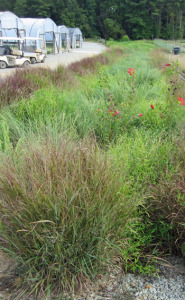New Direction Makes a Difference
Cleaner and better. Follow the water as it takes a new direction here at the nursery.
Read Post![By Bidgee (Own work) [CC-BY-SA-3.0 (http://creativecommons.org/licenses/by-sa/3.0)], via Wikimedia Commons Stormwater culvert](http://upload.wikimedia.org/wikipedia/commons/thumb/c/c8/Stormwater_culvert_along_Dobney_Ave.jpg/512px-Stormwater_culvert_along_Dobney_Ave.jpg)
Old School
It used to be common to move storm water off a property as quickly as possible. The water was whisked away, collected, and then treated somehow. However, with increased development and increasingly severe weather events, the old systems are being overwhelmed. And it can be prohibitively expensive to adapt these systems to handle the increased demand.
In the rural area where our nursery lies, we’ve seen a rise in development that increases runoff locally. We’re doing our part to manage storm water wisely and to create a system that’s sustainable and ecologically sound. That’s where green infrastructure comes in.
Keeping Water in the System

The goal in green infrastructure is to soak up and store water using management systems that mimic nature. Water is treated where it falls and is kept on site as much as possible. That’s what we’re working toward at Hoffman Nursery. We want to keep all water that falls on our site and reuse it. We have built systems that slow, treat, and direct water to collection areas where it can be used for irrigation.
With our systems, runoff from rain and our greenhouses is directed through a series of bioswales and wetland areas (see this earlier post on our bioswales). Most of these areas are planted with grasses and other perennials, which slows down the water and reduces sediment and pollutants. Water flows from these structures into sedimentation basins. The treated water can then be pumped up into holding ponds and used to supply our irrigation system.
In addition, slowing the water increases infiltration into the soil. That helps recharge groundwater, which keeps our wells filled so they can supply water when rainfall is scarce.

The First Inch
We currently have the capacity to handle the first inch of rainwater that falls on our site. Why is that important? The first inch of rainfall contains most of the pollutants and sediments a storm event will capture. After that first inch, the runoff is much cleaner and needs less treatment.
The system can always be better. We’re looking at cisterns for rainwatering harvesting and identifying areas that can be planted more densely to increase infiltration and filtration. Check back here on our website for updates.
Get Current Availability: Excel Download |PDF Download